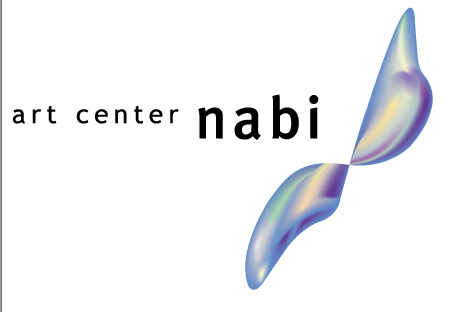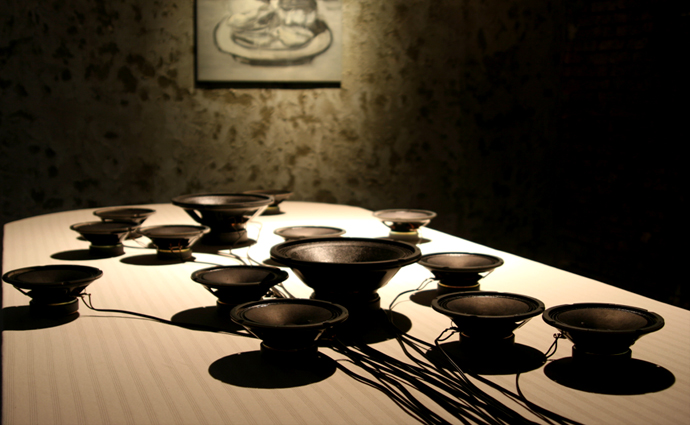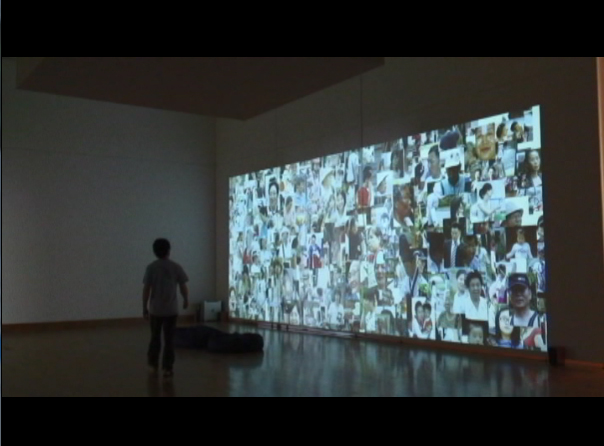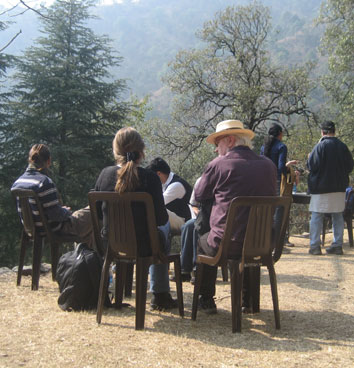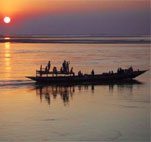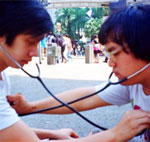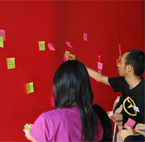seoul
Seoul, like Tokyo, has become a hub for media arts, with dedicated festivals, galleries and organizations all promoting activity in the field. Seoul and South Korea in general has a very high permutation of technology, 75% of households have broadband internet access, and a much higher percentage of people own a mobile phone. Technology is highly saturated in everyday life and Korean electronic manufacturers have seen great success. With the strong adoption of technology, there has also been seen a strong support for the creative applications for such media, and the production of creative content. There is great investment in innovation, the realms between art, design and commercial are increasingly blurred.

In such a technology saturated society there is a call for critical reflection upon the implementation of this technology and its social and political impact. There is now an emerging movement within the arts and also engineering, towards a questioning of our approaches to technology and challenging the current behaviours associated with this.
media city

Media City is one of the largest media art festivals in Asia. It is organized by the Seoul City Gallery and is held every two years. 2008 sees the 5th anniversary of its events. The festival takes place on an impressive scale, this year there are 65 artists participating from 28 countries, 10 of whom are Korean. The festival invites a group of international curators to select the artists from around the world, inviting these curators brings in more experience and often a regional focus. For instance this year a number of South American artists are participating. The festival is a big public event held in various locations around the city, with main exhibitions at the City Gallery, its audience is very wide which makes it necessary to carefully consider the different levels of media art and which would be most appropriate for the general public. This leads to an approach with combines media art with contemporary art. This year the committee have decided to emphasize the basics of media art in a reconsideration of its key principles Light / Communication / Time.
Joo Soon commented that Media City, despite being a large event is still unfamiliar to many people and is only engaging to narrow group, which they are attempting to widen. They must therefore establish a certain balance amongst the works and keep a certain openness to the theme of the festival in order to allow people to enter into it with more ease. Media City is aware that there are many cutting edge developments in the media art world but they also have a duty to relate this to more general topics and make it more digestible for a general audience. For example in 2006 the festival focused on Life and Media – the characteristics of new media influencing everyday life which they hoped most people could relate to in some way.
As part of Media City’s drive to raise awareness of new media art education program play a key role. Every festival includes a symposium and series of workshops/seminars. The workshops are particularly focused on children and try to encourage creative thinking in relation to new media. In these educational events they have introduced both old and new technologies, both the familiar and unfamiliar and encouraged an understanding of the working of these devices, including activities in which participants can make simple devices themselves. Furthermore Media City promotes deep theoretical discussion, balanced with practical experience in its symposium program. Media City is currently developing a special educational program based on the festival’s archive.
In 2006 I spoke with Rhee Wonil (then the director of Media City), he had a long experience of curating Biennale’s, contributing to the Shanghai, Taipei and Gwangju Biennales. He acknowledged that a Biennale has more political motivations than artistic, the huge boom seen internationally in biennale events, spotlighting cities around the globe, is used as a tool by national and local governments to promote the area to an international audience, encourage tourism and aid the economy.

We then spoke more generally about the state of media arts in Korea. New media has become absorbed into art, as it has into daily life, and there is often a difficulty to distinguish between these different areas. The popularity of new media has led to the vast commercialization of media art, in which artistic creativity is increasingly directed towards the commercial and corporate, in particular in terms of entertainment and advertising. The spread of new media has led to new cultures emerging especially in terms of blogging and the uses of mobile phones/devices.
Joo Soon emphasized the need to consider the characteristics of media itself and pointed towards more of a move in this direction in recent developments in Korean media arts. The challenge is how to develop this. She referred to models such as Eyebeam (New York) which stimulates collaboration between technicians and artists and suggested that there needs to be a new production system for artists in Korea and stressed the importance of networks to support this.
The relationship between artist and audience and media arts and contemporary arts are difficult issues but important. It is understood that there is often a conflict of interest which lies here. However it is this combination of contemporary art and media art which makes Media City distinct from other media festivals, as well as its focus on Asian artists. There is always a dual layer that one must be aware of in terms of media arts, one layer consists of those who are already actively engaged in this field and the other layer consists of those who have the potential to be interested. This is not only demonstrated in approaches of media city but also in other media forums, for example the internet based platform, Aliceon, which many involved in media city helped to initiate 4 years ago, starting as a forum for media artists, but now open for the general public and engaging with wider terms of media art including animation and gaming.
Conflict of interest but the necessity to be inclusive
art center nabi

Art Center Nabi is the media art hub for Seoul, sponsored by SK Telecom (one of Korea’s largest telecommunications companies), Nabi are dedicated to exploring the creative potential of new media. Nabi is a project based platform which aims to raise awareness of issues surrounding new media and engage the public in new thinking and practical exploration in these approaches. Nabi is very much concerned with research and education, with a strong international network which it draws upon to introduce new practices to the local audience.
Throughout the year it holds a variety of workshops, lectures, symposia, live events and collaborative sessions to bring together experts from different fields in a lively exchange, debating key issues raised by new media. Nabi have utilized a number of spaces throughout the city for the presentation of projects, including urban screens, and architecture, drawing attention to the presence of new media already in the city and encouraging alternative uses of these spaces. Major projects have included the international workshop ‘Urban Play and Locative Media’ and the recent ‘Act wisely, Eco friendly: Shall We?’.
so hyeon park

Park So- Hyeon is an old friend and a very active researcher and curator in the field of new media but also working more widely in the contemporary art field. She previously worked at NABI art centre where she fostered a program which brings artists and engineers together in collaboration and they are still continuing their activity independently through a variety of projects. So-Hyeon is deeply engaged in the investigation of the cultures and behaviours emerging around new technology and has instigated a number of projects which attempt to challenge or question some of these behaviours and allow for a more playful or creative approach. Her work can be seen as highly political but also very accessible to a general audience. One of her major projects has been ‘Urban Vibe’ realized in 2005, which brought together local artists, technology scientists and media critics in an investigation of media spaces in the urban landscape and how these can be adapted or created to facilitate new forms of social exchange. Please see the link for further details:
She is interested in the many different purposes which technology can be applied to – in particular its social and educational potential, while negotiating its commercial issues and pursuing a desire to generate creative contents relevant to a local area. She stresses the importance of ‘social hacking’, disrupting everyday behaviours and accepted systems in order to question their function, which she sees technology also playing a large role in.
She has recently established with a team of artists and engineers the company dotplay.org. The company aims to create creative contents for emerging technologies in particular the mobile phone. Examining the system of mobile media, they have dissected its components, hacked the technology and imagined new uses of the pre-programmed ‘black box’ which we carry with us. They have been running a series of workshops which allow people to learn more about the system of technology and how they might utilize this more creatively.
One her most recent projects of 2008 has been ‘Laboratory 01: Social Intervention’ bringing local and international artists together to investigate the potential of new media to challenge given social norms in the urban environment.
http://blog2.sangsangmadang.com/gallery/47
http://blog2.sangsangmadang.com/gallery/48
interactivity&practice Inp

INP are a pioneering collective of artists, engineers, scientists and media theorists who are concerned with taking a multi-disciplinary approach to media art and technology. Although coming from various backgrounds and experiences, they have come together in a close dialogue and collaboration in which they can share their skills and perspectives in the advancement of media-based projects. The results of their collaborations were first presented in Urban Vibe, and they have gone on to produce a number of other projects together.
*
taeyoon choi

Taeyoon Choi is one of the most active artists involved in questioning the role and utilization of media systems in our everyday lives and the impact on how we interact with others and our surroundings. His work does not only employ technology but takes a number of different forms, including walking, public sculpture, multiple player games and picnics. His greatest concern appears to be the social interaction between people, the different transactions which take place between them and how technology may play a role in this. He often subverts the use of media systems, transforming their function in the realization of alternative potentials, which challenges our acceptance of a particular standard.

A project of particular interest is Shoot me if you can which utilizes the mobile phone as a ‘weapon’ in a multi-player game which takes place on the city streets. Two teams battle against each other, playing out a physical realization of computer ‘shoot-em-up’ games, using the camera of their mobile phone to ‘shoot’ members of the opposite team, when your picture is taken, you are out of the game.
Sell
Your Morning Walk is a consideration upon the personal histories and
knowledge attached to a particular neighbourhood and how this
information can be transferred.
Participants were invited to guide audiences along their ‘morning
walk’, commenting upon personal landmarks and their experiences and
memories of the area. Along the walk technology such as GPS, PDA,
mobile phone, cameras etc, to provide a document of the event,
alongside drawings and written text, also calling into question
technology’s ability to convey such experience.
He
has recently completed a residency at Eyebeam, New York, where he
created
Camerautomata Charlie: Image Digesting Robotic Duck, a robot which
automatically took photographs and printed them out as it traveled
around tourist spots of New York.
The toy duck strolls around the area and systematically takes photos and
prints them out along its journey.
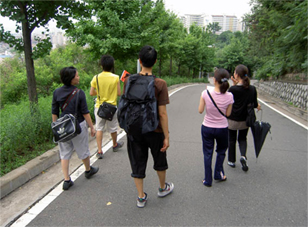
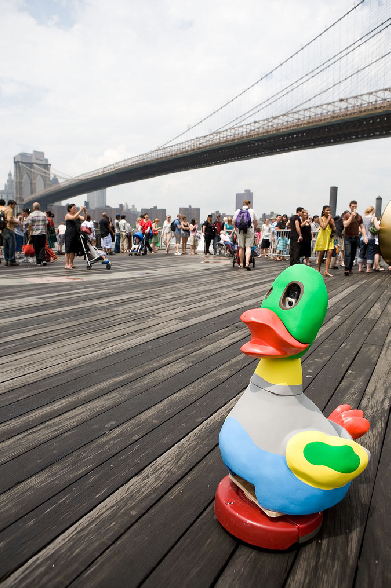
*
mioon

Mioon is a collaboration between two artists Min Kim & Moon Choi who met while studying in Germany in the late 90s. They have produced a variety of multi-media and interactive installations which have a particular focus upon the urban condition. They freely move between practices of sculpture, photography, installation and video and enjoy the flexibility which this brings. They have exhibited internationally including in the USA, Germany and Japan. Much of their work pivots around questions of the human in the city and ideas of collectivism and isolation. This has led them to investigate interactivity in their work, but also to challenge what it means to interact, what experience is engaged in and upon what terms. They are also very much concerned about the relationship between the artist and the audience and often attempt to disturb this in some way.
Their works include:
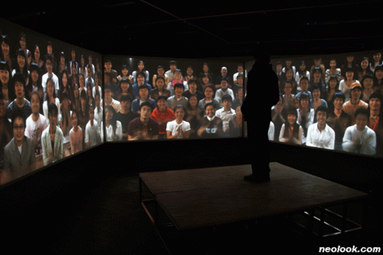 |
Aside of Audience In this work the viewer enters a stage area and is faced with a three screen display of an audience of 100 people. The individual audience member is no longer the viewer, but the producer, the artist. The audience asks them questions about their practice and philosophy of art and they must consider their personal responses. At times the central screen displays the responses of 100 people, who mostly have little connection to the art scene, who were documented as they were placed in the position of the artist, describing their purpose in making art and their driving concepts. The physical viewer may also participate in this work by filling in a questionnaire asking them to describe themselves as artists, or to pose a question to the ‘artists’ in the video. This work refracts the position of artist and viewer through a number of lines, firstly the audience in the video become the artist, the viewer is presented with a symbol of the artist and also asked to consider themselves as an artist. |
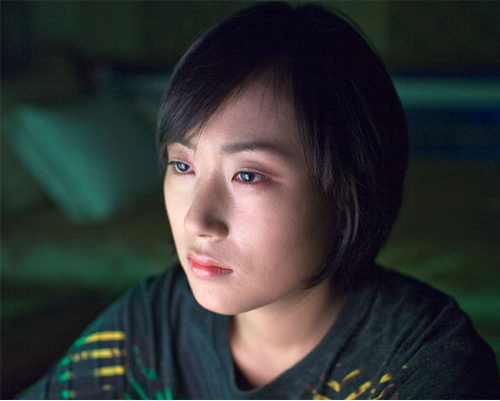 |
High Density project The questioning of perspective is further continued in High Density Project, a photography series capturing an individual’s absorption in playing computer games or watching television. |
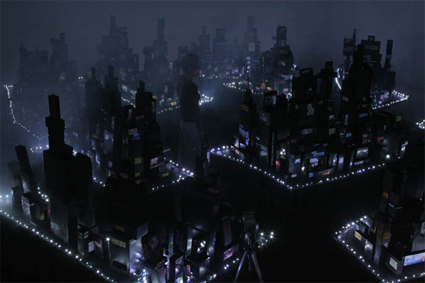 |
The visible City
An 8m x 8m miniature urban landscape created from cardboard and filled with CCTV cameras, this work makes the audience into giants, with a birds eye view of the city, but they are at the same time captured and locked within it as CCTV screens throughout the model present their movements through the space. |
A large scale sculptural work presenting the
busts of two human forms, connected by a bridge, and covered in
feathers, they become canvases for the projected images of huge
crowds of people who begin to fill the forms, and then move along
the bridge from one form to another, only to be suddenly dispersed
as fans within the sculptures blow the feathers in a rush of wind.
Tourist project
similarly utilizes feathers as a projection
screen, upon which are presented tourist holiday snaps from around
the world, however on approaching the screen the image is again
blown away into nothingness.
Holoaudience
takes the form of a stadium filled with a
holographic audience of 200 members. Upon the clapping of the
individual audience, the collective audience responds in waves of
movement in this kinetic sculpture, clapping back to the viewer and
questioning who is viewing who, and where does the audience lie in
this work.
Discussing the development of media art in Korea
they commented that in the late 90s there was an effective boom of
media arts in Korea but this then suddenly dropped after two years.
They are argued for the need to make developments more sustainable
in the field. Although audiences have been very receptive to new
media art, it is still a challenge to present such works in large
museums in Korea and galleries find such work problematic because
much of it is non-commercial/difficult to sell. The development of
media arts requires a responsibility both from artists and media art
promoters and necessitates a balance between the concept and the
media used.
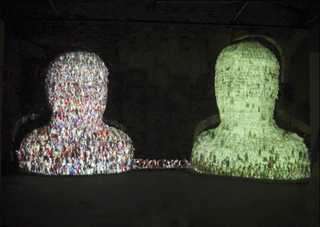
Human
stream
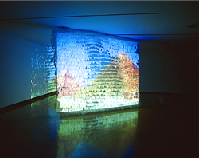
Tourist project
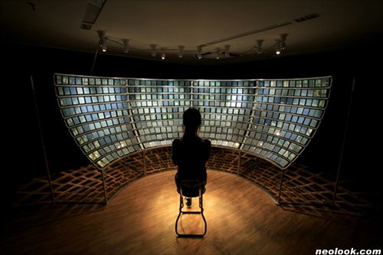
Holoaudience
nathalie boseul shin
Boseul Shin is a highly active curator with a particular focus on media arts. She is curator at Total Museum, a highly innovative space on the outskirts of the city, with unique architectural design. She is involved in numerous projects which aim to raise critical debate surrounding new media.

404 object not found is a project focusing on media archiving. Aware of the importance of documenting media art and questioning what will happen when the artist dies and the technology becomes obsolete, Boseul wants to promote an awareness that developments in media art now are creating an art history, they need to be recorded and documented now otherwise this information could be lost. So working with a group of 20 artists she explored these issues and archived the very process of developing the project through a project diary and interview archive which were then published as part of the exhibition. As part of this project she organized various workshops and lectures which examined methods of archiving and creating a platform for the sharing of documentation.

Another ongoing project which Boseul is curating is Coffee and Sugar. This is a collaborative project with several European institutions with out puts already realized in Bulgaria, Denmark and Turkey. This project takes the task of introducing new audiences to media arts. They want to offer stimulation, the coffee, but add sweetness, the sugar, to make it more comfortable to consume. Boseul describes it as wakeup with sweetness. Understanding the This project is not set in gallery spaces or museums but actually in coffee shops where video ipods were left on tables for people to watch short experimental videos from artists from all participating countries. There were also screening events held in the cafes. The project attempts to engage with everyday life and add some new element which could gain peoples interest without being threatening. The project also offered new exposures and opportunities for Korean artists to present their work in another context and another part of the world. The reaction of the audience/coffee shop customers was very positive and it is planned to expand the project in the future.


Yangachi is a young media artist currently experiencing great success, whom Boseul frequently works with. Recently they presented a workshop together ‘Trashed mobile’ in which they dissected a mobile phone and brought it back to a wired phone, reversing its so called evolutionary development. This workshop follows in line of projects in which Boseul has been attempting to bring engineers and artists together in new conversations which can lead to more open discourses in media arts and technology.
Boseul studied media art theory and was led to question what art becomes when the computer becomes the artist. She claims that media art is not for a public audience, it is currently only aimed at a very narrow group of people and alienates the majority. She therefore wants to challenge this and realizes the importance of giving enjoyment but also to challenge and make people think about the technology used in everyday life. Her aim is to bring emerging art forms into direct contact with society and present it in alternative spaces beyond the gallery, which often alienates a potential audience.
Boseul has also been working with a group of curators and artists creating work in relation to notions of disability. Collaborating with those with physical disabilities she directed an exhibition which questioned what it means to be disabled, the difference between and able body and a disabled body and how these terms are actually challenged through new technological developments, in which the body is being augmented but also the individual is in some ways disabled through their unfamiliarity with emerging technology and the need to learn systems. The exhibition prompted the audience to rethink their behaviours, and question the strength and weakness of the human body, whose senses are increasingly expanded by technology but also which becomes increasingly dependent upon this.
Digital playground
Digital playground is a yearly event which brings together the playfulness and enjoyment of new media with very social political strategies. This year the project is examining urban hacking, how to intervene in the city. At the time of preparations there were huge mass rallies against the import of American beef, creating a new dynamic in the city and a tension between expression and participation in the urban space and the powers of control enforced in these areas. A project which draws attention to urban activism and authorship in the city therefore had a particular resonance. Projects to be presented in this program include the work of a Slovenian artist who infiltrated government offices and Graffiti Research Lab who use strong lazers to write virtual graffiti on the city’s surfaces. The approach comes from very much an activist mentality which promote social/political awareness. Boseul emphasizes the need to protect misuse, to allow for systems to be subverted and interpreted in alternative ways. Her practice with regard to Digital Playground emphasizes our ability to hack the city. These involve highly political and social commentaries yet Boseul uses Digital Playground as a platform to introduce a general audience to these notions in a fun and playful way.
seung ah lee

Seung Ah approaches her practice from a range of positions which combine contemporary art, media art and theory while drawing on cultural studies and interactive design. She began to make media art related works around 2000, beginning with single channel video work, experiencing a strong influence from Nam June Paik. From here her ideas developed into an interest in social media design and the networks of urban space. She studied interactive design and theory at Goldsmiths College, London which allowed her to explore interactivity as communication between people and began to link this to cultural network and interactivity as well.
Seung Ah comments upon the fast movement of technology in Korea yet despite the ready adoption of technology there appears to be a lack of awareness amongst the public. She emphasizes the presence of a gap between the user and the technology. This is one of her motivations in trying to combine contemporary art and media art, to allow media concepts to reach a wider audience and gain popularity.
Her recent works combine drawing with simple interactive systems which react to the viewer’s presence or action. She is highly concerned with the networks and the facilitation of communication through technology, but also questioning what is lost and what is gained in this information transfer. Examples of this are shown in the work ‘whisper in every ear’ which presents a series of boards with microphones embedded in them, when the viewer blows on this or speaks into it, musically based sounds are emitted from speakers in another part of the space. The raw input is transformed into an unexpected output. In the work ‘You are in connection’ viewers adorn costumes fitted with sensors and enter a space with floor sensors too, measuring your position and your position in relation to other viewers resulting in transformations of sound and image which ask you to contemplate the connection between yourself, the others around you and unknown figures in the surrounding projections and drawings. Seung Ah comments that in a technological society we feel that we can connect with anyone at anytime, but the actual meaning of this connection is often lost, she attempts to make the audience reconsider the nature of this connection and its value.
ji-soo park

Ji-soo is a researcher at the Digital Media Lab of the Information and Communications University, Seoul. She studied design and media interaction in applied engineering in which she focused upon visual design, web design and the moving image. She says she is interest in the internet but not web design, she is more interested in the social construction of the internet. She has worked for Gucci as a combined media producer in marketing and also worked as a coordinator for Media City between 1999-2002. It was from this experience that she gained a strong inspiration to investigate the creative possibilities of interactive design. While progressing professional and technical skills in physical interface development and communication design for a media integration company, she began to explore creative outputs for her skills particularly in the field of interactive design for architecture.
Evolving from her postgraduate research on space and mobile culture she developed artistic projects which utilized mobile phone technology. Ji-soo also fascinated by the memory of place and the shared experience of place she began to investigate what role technology plays in this. 1994 saw the beginning of mobile phone in Korea, and its use rapidly accelerated from here. Ji-soo realized what a big role the mobile plays in communication and was motivated to use it in some way in her projects. She was particularly intrigued by the way that the mobile phone was increasingly functioning as a friend to the individual and social meaning and customs were being built around it. A project which has had a particular influence upon her is ‘Amodal Suspension’ by Rafael Lozano Hemmer. In this project personal mobile phone messages were converted into beams of laser light, which were projected into the night sky. These beams could then be caught and the messages read by the public.
In the project ‘Mobile Heart-now and here’ created for Media City 2006 online and mobile technology was used in an attempt to link different areas of the city together. Resembling very much a social networking forum the artist and participants documented their movements though these spaces, coming together in the virtual space of the web, in which a timeline, location map, friend finder service and archive were utilized to facilitate communication between the different neighbourhoods. Participants in these locations could upload their own content, in particular digital images, video and text describing their experiences of these places and their attachments to them, in an attempt to document and express place through digital means.
Her next project following on from this focuses upon the mobile phone, in particular text messaging, which for many young Koreans is now the most popular form of communication, it is almost a form of entertainment, Ji-soo comments. The hi-tech is already highly integrated in everyday life and strong cultures of this technology, in particular surrounding the mobile phone are already prevalent. Her project here investigates now this communication can be transformed in some way, how technology can offer emotion and encouragement to the user. Taking inspiration from Rafael Lozano-Hemmer’s work she developed a system that would transform the data and communications of the mobile phone into animations and illuminations, encouraging a new interaction between people in a given space.
A recent project is ‘Aaora’ which was presented at the new capital centre, Jochiwon. (This city is being promoted as an alternative capital to Seoul and to bring a new direction in history) She presented her work in the exhibit section for making happiness. Displayed in a mirrored room, aurora consisted of thousands of fibreoptics lit with LEDS, suspended in mid air in the wave like pattern of the aurora. With a range of 22 colours the lighting followed the movement of people in the space. Ji-soo sees the aurora as a metaphor for human society, which expresses a certain fragility yet beauty. She also wishes to explore in this work the different things we are drawn to in the space between earth and outer space and how this may aid us in locating ourselves and finding meaning. The next development for this project is to relate it to air pollution/temperature conditions through web-based information.
Ji-soo is now developing a new project which will be presented in a workshop format. In an attempt to investigate the penetration of technology she is implementing this project in rural countryside areas, usually not associated with concentrated technological infrastructure. She has been working with various groups in the rural region, including young children and responding to their views on technology and new media. This project combines the physical and the virtual. Ji-Soo is caught by the meaning of interaction, aware that much of what is called interactive in media art and design occurs only on a very superficial level and she is motivated to find some deeper level of understanding in this. She is planning to work closely with participants from different age groups and different communities through practical acts of making objects, but also exploring animation, video and the creative possibilities of mobile phones and the internet.
young sup kim

Is an artist who is deeply investigating the relationship between sound and physical form in a combination of the visual and non-visual. Here the very elements which are used to convey sound (the speakers, the wires) are used as sculptures. Young Sup comes from a conceptual background and has long since been engaged in notions of language, misconception and miscommunication which he appropriates in his practice. Through the development of his work he has come to increasingly question the impact of technology upon our ability or inability to communicate, which a number of his works have commented upon.
Recent works such as ‘Delicious Dinner’ have been critical of consumerist society and challenge the appetite of human desire, which Kim sees as a forced appetite. In this work speakers are presented like dishes upon a table though which the sounds of shopping malls and advertising can be heard. Kim also acknowledges technology’s role in generating this appetite and in the work ‘Gulp!gulp!gulp!’ presents cups formed of audio cable from which the sound of the clicking of a computer mouse can be heard, commenting that internet culture is creating a thirst which can not be satisfied. Another related work consists of 20 large dinner plates (made from speakers and cable) on a large table. These plates emit the sounds of someone typing on a computer. Here the idea of the dinner proposes a social or formal meeting and Kim equates this with online meetings.
In earlier works he made as a student in Germany he was very much occupied with ideas of language, cultural difference and the basis of art itself, reflecting his experiences in this other context. Commenting upon the flood of information which was is subjected to in a city and the difficulty of digesting this information, especially if you are new to the city, Kim created a work in which the speakers are installed in the formation of a forest, yet the sounds that can be heard are those of the city, a bombardment of sound, which breaks down into incomprehensibility.
.
The artist if of course constantly asked to face the heavy question of What is art ? Which of course can not be easily answered, if at all, so it is often like searching for a radio channel one quite being able to reach right position. In reaction to this thought he created a work where the sound of radio tuning is emitted from large speakers but these speakers are muffled by piles of books on top of them. Also in his pursuit in the investigation of language and cultural difference which he was made to be very aware of, studying in Germany, the work ‘13’ focuses on the use of symbol in different cultures. In European culture the number 13 is associated with ill fortune and a bad omen however in his own Korean culture 13 has no meaning. He attempted to contrast this opposition of meaning and meaningless, west and east perspective. In this work he presents 13 large speakers stacked in suspension one above the other, 12 of which emit the sound of television, one emits only white noise.

bei kyoung lee

Bei Kyoung lee is another artist who studied in Germany and has built a long relationship with media art. He first studied sculpture and then became interested in video and wanted to learn more about its structure. His first video work was a video installation Mr. m in 1994. He began to investigate video as a medium through which to communicate space in a highly sculptural sense. In this investigation the position of the audience and their relation to the work became a key focus.
This naturally led to an interest in interactivity or responsive environments. For example In ‘Videokappelle’ a projection wall of 10 sections responds to the presence of the viewer, the projected image of a particular section being revealed only when the viewer is within that area. 'Selftime' developed this concept further in the attempt to express one moment, and the difference in meaning of this moment for each individual. Here the colour of the projected image graduates according to the length of time the viewer remains before the work, in what Bei Kyoung calls natural interaction. Sound in the installation is also reactive to movement. Bei Kyoung attempts to use these audio visual elements to express an individual’s different sense of time and to capture various moments of experience and contemplation.
Insel approaches the existence of various places/locations which are present within our mind and proposes the body as a gate to elsewhere. The work consists of a projection presenting an image of Koln city centre, the image is static but as the viewer moves into the image, their shadow cast upon it, the streets become full of movement and bustle of people and traffic, the moving image being taken live from the city centre.
The concern with movement of crowds and the relation between the gallery environment and the street environment are continued in ‘Beyond the Bigbang’ which presents an abstract image, one point centre of image information which is reactive to the movement of people on the street. Bei Kyoung continues to pursue his interest in the relation between movement and video in 'That Time' which takes a live scene from curators office window, and this image is made to respond in direct relation to the flicker of a candle and concrete sound from the surroundings is transformed into the sound of wind.
Bei Kyoung demonstrates a keen awareness of the relationship between the gallery and the outside world and in many of his works attempts to directly link the two together.
ssamzie space
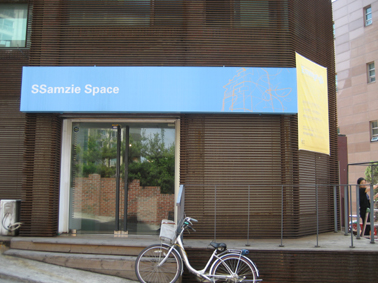
Ssamzie Space was founded in 2000 as a space to promote the work of young artists. This non-profit gallery space also hosts a significant archive on contemporary art and also hosts a regular experimental music club night. The space also provides a studio for guest artists and runs a curator in residence program. It offers remarkable support for emerging artists and arts practitioners.
*
heyri art village

Heyri Art Village is located towards the north of Seoul in an isolated area, which has been redeveloped to become a hive of artistic activity. The large area is scattered with contemporary architecture each housing artist studios, performance spaces and galleries.
leeum, samsung museum of art
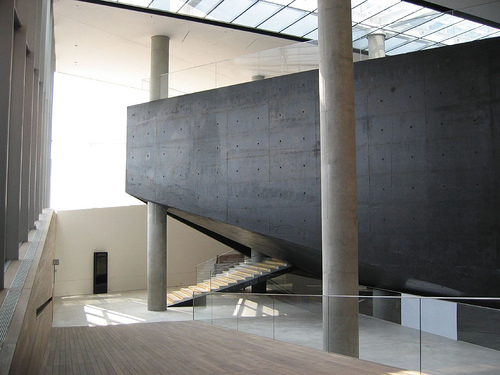
Leeum is an impressive museum of modern and contemporary art as well as historic artefacts. It houses a permanent collection of Korean and International works, along with a regular changing exhibition of both contemporary and traditional arts.
http://leeum.samsungfoundation.org
*
cant remember
 ..................................................................................
..................................................................................
............................
.........................
...............................
*
sangsangmadang
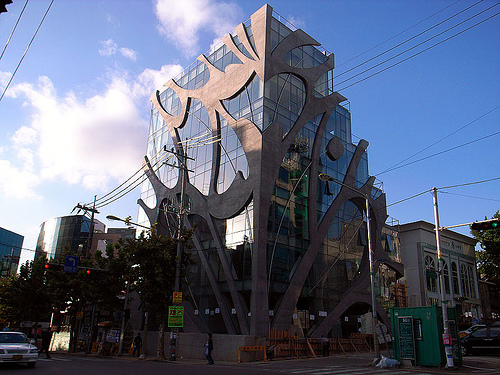
Sangsangmadang opened in 2007, a newly built space hosting a cinema, studios, archive, design shop and gallery. The gallery is committed to promoting cutting edge contemporary arts and international dialogue in the field. Hosting exhibitions of both local and international artists projects have included an overview of emerging talent in Korea in 'Battle of Taste' and the recent festival Laboratory, which included artists from the USA and Germany working alongside Korean artists.
http://www.sangsangmadang.com/
*

